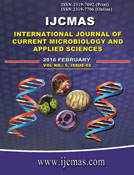


 National Academy of Agricultural Sciences (NAAS)
National Academy of Agricultural Sciences (NAAS)

|
PRINT ISSN : 2319-7692
Online ISSN : 2319-7706 Issues : 12 per year Publisher : Excellent Publishers Email : editorijcmas@gmail.com / submit@ijcmas.com Editor-in-chief: Dr.M.Prakash Index Copernicus ICV 2018: 95.39 NAAS RATING 2020: 5.38 |
Candida species are the most common fungal pathogen isolated from clinical samples. Of late, improper use of antifungal drugs in critically ill patients has favoured antifungal drug resistance amongst Candida. To isolate and identify Candida species from hospitalized patients and determine their antifungal susceptibility profile by conventional (Epsilometer i.e., E-test) and automated (VITEK-2) methods. This cross sectional study was carried out from December 2012 to June 2014 from hospitalized patients at a tertiary care centre, in which 50 non-repetitive clinical isolates of Candida were analysed. The identification was carried by conventional methods as per standard laboratory protocols and by VITEK-2 Compact (Biomerieux, France). The antifungal susceptibility testing (AFST) of these isolates was carried out by E-test and VITEK-2 Compact (YST cards- AST YS01). Out of 50 isolates, 36 (72%) were non-albicans Candida and 14 (28%) were C.albicans. AFST by VITEK-2 showed that only 2 isolates (4%) were resistant to fluconazole and E-test showed that 24 isolates (48%) were resistant to fluconazole and voriconazole but all were sensitive to amphotericin B. There was substantial agreement of 80% (95% CI of 69 – 91%) for identification and less than chance agreement for AFST between VITEK-2 and E-test. We conclude that E-test can be a simple and convenient method for AFST when compared to VITEK-2. We cannot rely only on VITEK-2 for AFST. Identification and AFST of Candida isolates must be carried out for optimum patient care.
 |
 |
 |
 |
 |